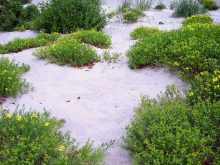General notes
Distribution
Collecting
Research
Photography
Literature
Internet
Acknowledgement
Imprint
 For the study of robber flies it is imperative to build a comparative collection. To efficiently collect many species in a short amount of time, it is helpful to learn about their biology (cf. MUSSO, 1978).
For the study of robber flies it is imperative to build a comparative collection. To efficiently collect many species in a short amount of time, it is helpful to learn about their biology (cf. MUSSO, 1978).
A joint field trip with an experienced colleague could be very helpful.
Because there are no general rules for catching Asilidae, a creative approach is necessary. The following equipment can be helpful for collecting:
- insect nets (with a strong frame and fine net curtain)
- Mailaise traps
- pan traps on the ground and on fallen trees (usually yellow-colored)
- emergence traps of different shape
Robber flies lie in wait for their prey at special resting points. This can be advantageous for the collector. If the first catching attempt is unsuccessful, it can often be repeated after some time, because the flies occasionally come back to the same place.
Resting points are: bare soil without plants, tips of grass and leaves, dry branches, stones, sunny tree trunks, etc. (cf. research).



It is worthwhile to keep a diary about the expedition and record special information on the behavior of the animals, which will shed more light on their biology.
 Because of the fine tomentum of several species, it is absolutely necessary to protect the collected flies against humidity. This can be achieved by putting a lot of dry paper inside the collecting jar and to using only specific poisons like ethyl acetate. In addition, some specimens should be killed and preserved in 95% ethanol, so they can be used for DNA analysis as well. After killing, it is necessary to prepare them very carefully. It is important to open the wings slightly and fold the legs under the body. Sometimes it is helpful to dissect the genitalia. To separate the genitalia it is the best to cut the end of the abdomen between the 5th and 6th segment. Then cook the segments in a small glass-tube in 10% KOH for some minutes. With the aid of a fine pointed forceps and microscissors it is possible to dissect the different structures. The genitalia should always be kept with the insect. The best way to store dissected genitalia is in glycerin in a plastic microvial which can be mounted on the same pin as the fly. The specimen label should contain the following information: Country, province, distance to the next bigger city, date, geographical coordinates and further notes, like habitat and behavior.
Because of the fine tomentum of several species, it is absolutely necessary to protect the collected flies against humidity. This can be achieved by putting a lot of dry paper inside the collecting jar and to using only specific poisons like ethyl acetate. In addition, some specimens should be killed and preserved in 95% ethanol, so they can be used for DNA analysis as well. After killing, it is necessary to prepare them very carefully. It is important to open the wings slightly and fold the legs under the body. Sometimes it is helpful to dissect the genitalia. To separate the genitalia it is the best to cut the end of the abdomen between the 5th and 6th segment. Then cook the segments in a small glass-tube in 10% KOH for some minutes. With the aid of a fine pointed forceps and microscissors it is possible to dissect the different structures. The genitalia should always be kept with the insect. The best way to store dissected genitalia is in glycerin in a plastic microvial which can be mounted on the same pin as the fly. The specimen label should contain the following information: Country, province, distance to the next bigger city, date, geographical coordinates and further notes, like habitat and behavior.
In principle it is advisable to obey the nature conservation laws of the different countries you are going to collect in. Some countries do not allow insects to be collected without permission and it is recommended to ask for written permission before attempting to collect.
Contents: © Fritz Geller-Grimm, Jorge N. Artigas, 2007
Layout & images: © Fritz Geller-Grimm, 2007